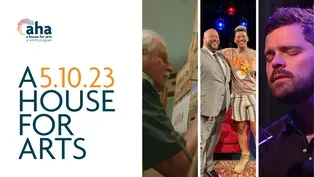
Paintings of a Historic New York State
Clip: Season 8 Episode 27 | 7m 27sVideo has Closed Captions
See what our area looked like hundreds of years ago.
Len Tantillo has been painting historical scenes of New York State for over 40 years. See what our area looked like hundreds of years ago in this clip from AHA! A House for Arts.
Problems with Closed Captions? Closed Captioning Feedback
Problems with Closed Captions? Closed Captioning Feedback
AHA! A House for Arts is a local public television program presented by WMHT
Support provided by the New York State Council on the Arts (NYSCA), M&T Bank, the Leo Cox Beach Philanthropic Foundation, and is also provided by contributors to the WMHT Venture...

Paintings of a Historic New York State
Clip: Season 8 Episode 27 | 7m 27sVideo has Closed Captions
Len Tantillo has been painting historical scenes of New York State for over 40 years. See what our area looked like hundreds of years ago in this clip from AHA! A House for Arts.
Problems with Closed Captions? Closed Captioning Feedback
How to Watch AHA! A House for Arts
AHA! A House for Arts is available to stream on pbs.org and the free PBS App, available on iPhone, Apple TV, Android TV, Android smartphones, Amazon Fire TV, Amazon Fire Tablet, Roku, Samsung Smart TV, and Vizio.
Providing Support for PBS.org
Learn Moreabout PBS online sponsorship(light airy music) - Today we're gonna take a step back in time, through the historical paintings of artist Len Tantillo.
Follow me.
- [Len] For the last 40 to 45 years, I've been painting New York State historical subjects and marine paintings.
The history of New York State in particular, is an epic story.
I think the thing that I found so intriguing about history as a subject, is that I could go anywhere with it.
I can go anywhere in time with it.
I can go anywhere in space with it.
I can deal with all manner of activity.
The construction of cities, the evolution of watercraft, the effects of mechanized transportation system when the railroad gets built.
It's been an incredibly exciting adventure for me.
(gentle hopeful music) My mother was pretty artistic.
She wasn't a painter, but she was interested in art and she encouraged me to draw.
What I was looking for then, and maybe even what I'm seeking now, I've said this to my friends who were professional artists, we want our moms to take our pictures and put them on the refrigerator.
That's a big deal.
And whether you're talking about a museum today, it's that validation of someone, who is out there interested in what you're doing.
So I think because my mother did that, I got my my rewards and my incentive to make another one.
And I don't know, there's probably still a little of that lingering.
I'm sure it's in here someplace in the studio.
(gentle calming music) We seem to have a historical inferiority complex.
Oh, when I say an inferiority complex, I mean that the great moments of American history happened somewhere else.
They happened in Philadelphia, they happened in New York, they happened in Boston.
But in actuality, history happened everywhere.
I kept thinking about how could you break through and make people proud of where they lived?
I felt that the way that I could contribute to that feeling, would be to create images of the world right around us, right under our feet, right in the places that are so familiar to us.
If it was possible for time travel, that we could go back and look at the 17th century, the 18th century, the 19th century, maybe we'd have a greater appreciation for where we live.
When I'm creating a painting of a specific historical setting, I want it to be the most credible image that it can be.
So when I start a project, it's frightening.
It's like staring into this abyss and stepping off into it.
I start to grab the component pieces of it.
This was written, this might have been sketched by somebody, this was found in the ground.
I try to learn as much as I can about the sight.
So I get the lay of the land.
Is it hilly, is there a river, is there a stream?
Is there a lake?
And then I start to think about, like the people, who are these people?
I was probably most challenged when I was depicting my first few Native American scenes.
I don't know anything about the cultural experience of being a Native American.
What do I know?
I know how a father can love his children.
I know how a mother can be a teacher.
I know how cold it gets in New York state.
I know what it's like when it's 10 or 20 below 0, and the snow comes up to your knees.
So those are the things I know I can build into that picture, that relate to us all as human beings.
Once I've done the research, this is a big part of creating a painting, is how do I compose this?
I would build models.
I would build models out of cardboard.
Then I could sort of move it around and try to judge what was the best angle to depict this subject.
I was working on a project that involved a vessel that the Scarano brothers were building in Albany at their boatyard.
One of their designers there, he was working with a 3D program.
And he had a 3D model of the vessel they had just finished.
And I thought, "Wow, I've gotta learn how to do this."
The outcome of that was, I wasn't limited by space anymore.
So I built enormous models.
The next big component is color.
In addition to composition, that's the next most important thing because people have an emotional response to an image based on that.
That's actually, it's their first impression.
It's not the composition, it's what these colors are doing.
I used to go to museums and just watch people walk through galleries, and just to see how much time they would spend looking at each painting as they walk through the gallery, and where they stopped.
Why did they stop on that picture?
What was it about that picture that made them pause and really take it in?
And it was usually the dynamics of its color.
An atmosphere that reminds us, that can bring us to that experience on a dreary, rainy day, or that experience of some majestic space, you know, where you can see out miles in all directions.
This is how you could manipulate someone's attention.
And if I could get their attention, and the composition was strong enough, then I could tell you a story, and that's when I could get to the history.
And maybe what you would come away with is, you learned something about this place where you live.
(bright upbeat music) - [Matt] So, have you found your validation?
Do you feel- - [Len] Oh, did my mom put the pictures on the refrigerator yet?
Almost.
You are always striving for that, you know, and I mean, God, I've been at this for such a long time, and it seems like each time you're starting over again, right from that same place.
You know, the blank piece of paper and the pencil, and you know, what's this gonna be?
And in the end, maybe, mommy will like it.
(laughs)
Video has Closed Captions
Preview: S8 Ep27 | 30s | Explore paintings of historical scenes of NY, learn about the Connect Center in Cohoes, NY (30s)
Interview: Ben Williams of The Connect Center in Cohoes, NY
Video has Closed Captions
Clip: S8 Ep27 | 6m 45s | Learn how art plays an important role at the Connect Center. (6m 45s)
Providing Support for PBS.org
Learn Moreabout PBS online sponsorshipSupport for PBS provided by:
AHA! A House for Arts is a local public television program presented by WMHT
Support provided by the New York State Council on the Arts (NYSCA), M&T Bank, the Leo Cox Beach Philanthropic Foundation, and is also provided by contributors to the WMHT Venture...













